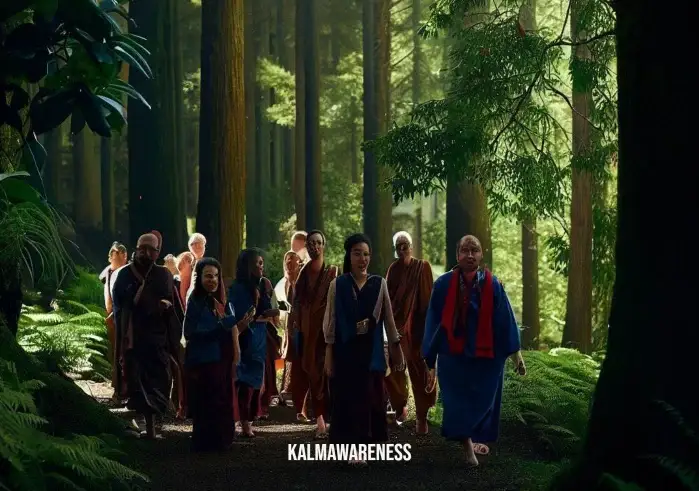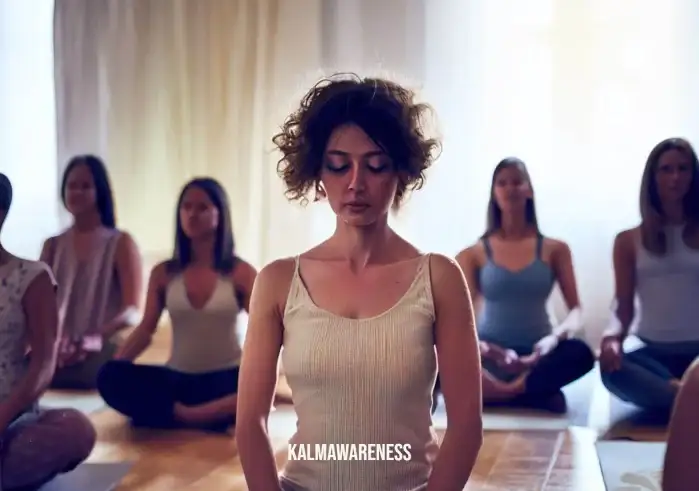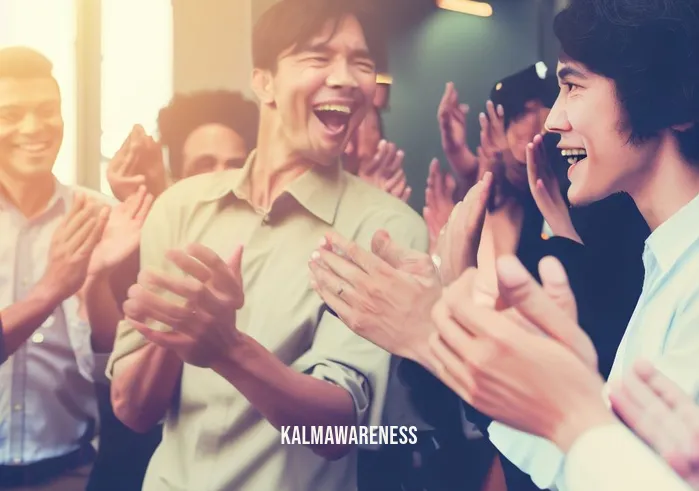Dharma Talk Yoga: A Journey Towards Self-Reflection and Awakening
The spiritual landscape of yoga unfolds much beyond the physical postures. At its core, it’s a pathway leading us to the wellspring of wisdom within. Central to this wisdom is the concept of Dharma. Hence, in this series, we’ll explore the essence of Dharma Talk Yoga, a practice of self-reflection, spiritual teaching, and philosophical insight. Let’s take a dive into the depth of yoga beyond the mat. Welcome aboard!
Understanding Dharma Talk Yoga
Dharma Talk Yoga, as the name suggests, is a fusion of ‘Dharma talks’ – spiritual teachings primarily rooted in Buddhism, and ‘Yoga’ – an ancient Indian practice. This potent blend offers us a holistic method to deepen our understanding of the self, our purpose, and the intricate weavings of life.
To begin with, Dharma is a multifaceted term often translated as ‘righteous duty’ or ‘law of nature’. It is the guiding principle that invites us to act in alignment with our true nature and purpose. In the context of Yoga, Dharma becomes the moral compass guiding our journey towards enlightenment and liberation.
Moreover, the practice of Dharma Talk Yoga goes beyond the confines of a yoga studio. It’s an invitation to expand our awareness, engage with life more fully, and transform our experiences into profound life lessons. It is about living in the ‘here and now’ and recognizing that each moment presents an opportunity for growth and self-realization.
Drawing from the wisdom of the Mindfulness to Meaning Theory, we understand that being present and mindful can lead us to a profound sense of interconnectedness and meaning in life. This awareness can be the catalyst for positive transformations and a greater sense of fulfillment.
The Power of Inquiry and Curiosity
“The important thing is not to stop questioning. Curiosity has its own reason for existence.” – Albert Einstein
One of the primary steps in Dharma Talk Yoga is to nurture the spirit of curiosity. Is curiosity a feeling? More than just a feeling, curiosity is an innate human trait that drives learning and discovery. In our context, it’s the flame that lights our way on the path of self-discovery and spiritual growth.
It prompts us to question our automatic thoughts and patterns, encouraging a deeper investigation into our beliefs and perceptions. Much like the Buddhist concept of Don’t Know Mind, it allows us to approach life with an open mind and heart, ready to embrace the wisdom that comes our way.
The Interplay of Mind and Heart
The practice of Dharma Talk Yoga involves a delicate balance between mind and heart. It’s a journey where the mind guides the heart, and the heart informs the mind. This interplay offers a deeper understanding of our emotions, longings, and desires.
On this path, you may find yourself asking, Is longing an emotion? Longing, in its essence, is a deeply human emotion that often signifies a yearning for connection, wholeness, or the divine. It’s not uncommon for such feelings to surface during our Dharma Talk Yoga journey. Rather than pushing these feelings away, we learn to acknowledge them, understand their root cause, and direct them towards our spiritual growth.
In our exploration of Dharma Talk Yoga, we’ve merely brushed the surface of its profound depths. In the next part of this series, we’ll delve deeper into the practice, discussing how it aligns with Buddhist teachings, the role of meditation, and more. We invite you to continue on this enlightening journey with us.
Stay tuned for the next installment where we will dive into the relationship between Dharma Talk Yoga and Buddhist views on love, the significance of meditation, and the tools for grounding these practices into our everyday lives. Let’s embark on this journey to awaken, grow, and transform together!

Dharma Talk Yoga: Unfolding the Buddhist Teachings and Practices
In the second chapter of our series on Dharma Talk Yoga, we traverse the territories of Buddhist teachings and meditation practices. Both of these elements, embedded in the heart of Dharma Talk Yoga, offer profound insights to guide us on our journey towards self-realization and spiritual awakening.
Buddhist Teachings: A Cornerstone of Dharma Talk Yoga
Intrinsically linked with Dharma Talk Yoga are the core teachings of Buddhism. Just as yoga is not merely a physical exercise, Buddhism is more than a religion—it’s a philosophy, a way of life.
One of the central tenets of Buddhism aligns with the foundational principles of Dharma Talk Yoga, which is the idea of ‘Anatta’ or non-self. This concept encourages the understanding that our true essence transcends beyond our physical form and the fleeting mind.
The practice of Dharma Talk Yoga prompts us to contemplate on the statement, ‘I am not the body, I am not even the mind.’ It gently guides us to observe the transient nature of our thoughts, emotions, and physical sensations, and realize our true self, which is unchanging and eternal.
The Four Noble Truths
Another vital element of Buddhism that weaves into Dharma Talk Yoga are the Four Noble Truths:
- The Truth of Suffering: This recognizes that life inevitably involves suffering or dissatisfaction. In the grand scheme of things, our suffering provides a fertile ground for growth and transformation.
- The Truth of the Cause of Suffering: This identifies the root cause of our suffering, often tied to our desires and attachments. Reflecting upon Is longing an emotion?, we realize that our unfulfilled longings often lead to discontent.
- The Truth of the End of Suffering: This offers hope, reminding us that it’s possible to transcend suffering by letting go of our attachments.
- The Truth of the Path Leading to the End of Suffering: This outlines the Eightfold Path, a practical guide to liberate ourselves from suffering.
Harnessing the Power of Meditation
The practice of Dharma Talk Yoga encourages incorporating meditation as a significant part of our spiritual journey. Buddhist teachings emphasize meditation as a powerful tool for self-discovery and awakening.
From Mindfulness Meditation to Insight Meditation, these practices foster a heightened sense of awareness and deeper understanding of our experiences. Moreover, engaging in meditation circles can provide a supportive community for shared learning and growth.
Here’s a brief overview of some common types of meditation:
| Type of Meditation | Description |
|---|---|
| InsightLA Audio | A guided meditation series for developing mindfulness and insight. |
| Meditation for Awakening | Practices focused on cultivating consciousness and spiritual awakening. |
| Meditation Story | Incorporates storytelling to foster deeper understanding and relaxation. |
As we journey ahead in our exploration of Dharma Talk Yoga, we’ll delve deeper into the world of meditation, discussing various techniques and their benefits in our next chapter. In addition, we’ll explore the intersection of Dharma Talk Yoga with other practices and philosophies, such as the 7 Levels of Existence and the Mindfulness-to-Meaning Theory.
Stay tuned for more enriching insights and learnings in the next installment of our series on Dharma Talk Yoga.

Dharma Talk Yoga: Drawing from the Wellsprings of Wisdom
In the third part of our exploratory series on Dharma Talk Yoga, we embark on a journey through the treasure trove of wisdom, drawing from the insightful words of profound thinkers and yogis. Inherent to the philosophy of Dharma Talk Yoga are threads of wisdom, woven intricately through famous quotes, shedding light on the path of self-discovery and enlightenment.
Timeless Words of Wisdom in Dharma Talk Yoga
Wisdom is an integral part of Dharma Talk Yoga. The philosophies and practices it espouses have been echoed down the centuries in the words of countless enlightened beings. As Jack Kornfield, a renowned meditation teacher, emphasizes, “Meditation is not evasion; it is a serene encounter with reality.” This quote encapsulates the essence of Dharma Talk Yoga, which encourages us to meet our inner reality with mindfulness and serenity.
Similarly, Mirabai Bush, a key contributor to the contemporary mindfulness movement, inspires us with her words: “The best way to capture moments is to pay attention. This is how we cultivate mindfulness.” In Dharma Talk Yoga, we learn to cultivate this mindfulness, focusing on the present moment to glean wisdom from each experience.
A Beacon of Guidance: The 7 Levels of Existence
The 7 Levels of Existence offer a spiritual roadmap for personal growth and self-realization, principles that Dharma Talk Yoga upholds. These levels provide a deeper understanding of our existence, helping us realize our spiritual potential.
- Physical Level: Our physical body and the tangible world.
- Astral Level: Our emotions and desires.
- Mental Level: Our thoughts, intellect, and ego.
- Causal Level: Our higher mind, intuition, and creativity.
- Cosmic Level: Our enlightened self, embodying love and compassion.
- Nirvanic Level: Our divine self, the essence of peace and unity.
- Absolute Level: The ultimate reality, the essence of all existence.
Through the practice of Dharma Talk Yoga, we are guided on a journey through these levels, from the physical to the absolute, enabling us to unfold our spiritual potential.
The Mindfulness-to-Meaning Theory
In line with the spirit of Dharma Talk Yoga, the Mindfulness-to-Meaning Theory posits that mindfulness helps us draw meaningful insights from our experiences. It emphasizes how mindfulness serves as a bridge, connecting our experiences to a broader understanding of life.
“In the end, just three things matter: How well we have lived How well we have loved How well we have learned to let go” — Jack Kornfield
In conclusion, Dharma Talk Yoga offers a holistic path to spiritual awakening, integrating the wisdom of profound thinkers, the guidance of the 7 Levels of Existence, and the insights from the Mindfulness-to-Meaning Theory.
In our next chapter, we’ll venture into the realms of the spiritual dimensions of Dharma Talk Yoga, exploring its connections to love, the concept of impermanence, and the mantra ‘Baba Nam Kevalam’. We invite you to continue with us on this enlightening journey through the intricate world of Dharma Talk Yoga.

Dharma Talk Yoga: Illuminating the Path with Hope and Confidence
In the fourth part of our ongoing exploration of Dharma Talk Yoga, we delve into the heartening and uplifting aspects of this practice. Dharma Talk Yoga is more than a physical discipline or a mental exercise—it’s an empowering journey of self-realization that infuses hope and bolsters confidence.
The Enlightening Mantra: Baba Nam Kevalam
The Sanskrit mantra, “Baba Nam Kevalam,” meaning “Love is all there is,” is a cornerstone of Dharma Talk Yoga. It serves as a potent reminder of the primacy and universality of love, offering solace and hope to those who chant it. It echoes the sentiments of the renowned philosopher, Pierre Teilhard de Chardin, who once said, “We are not human beings having a spiritual experience. We are spiritual beings having a human experience.”
The Embrace of Impermanence
One profound teaching in Dharma Talk Yoga relates to the acceptance of impermanence. As eloquently captured in the wisdom of the Buddha, “Life isn’t about how many breaths you take, but about the moments that take your breath away.” By cultivating an understanding of the transient nature of life, we find hope and courage in every changing moment.
Building Resilience and Confidence: Mindful Exercises
Dharma Talk Yoga also provides tools to build resilience and confidence through mindfulness. Here is a brief table illustrating a few mindful exercises:
| Mindful Exercise | Description |
|---|---|
| Mindful Mushrooms | A visualization exercise that encourages grounding and connection with nature. |
| Mindful Roots | A practice that helps you establish a strong foundation, symbolizing resilience and stability. |
| Mindful Prayer | A contemplative practice that cultivates a sense of gratitude and awareness. |
“Everything you need, your courage, strength, compassion and love; everything you need is already within you.” – Unknown
Dharma Talk Yoga, with its rich tapestry of teachings, provides us with a myriad of ways to tap into the inherent hope, strength, and confidence that reside within us.
In the concluding chapter of our series, we’ll dive into the restorative aspect of Dharma Talk Yoga, how it intertwines with rest, restoration, and the rise of feminine energy. We invite you to continue on this path of learning, immersing yourself further into the transformative world of Dharma Talk Yoga.

Dharma Talk Yoga: Embracing Rest, Restoration, and Feminine Energy
In our final chapter, we’ll discover another profound facet of Dharma Talk Yoga: its emphasis on rest, restoration, and the rise of feminine energy. This approach not only contributes to physical well-being but also creates a fertile ground for spiritual awakening and self-realization.
Rest and Restoration: The Yin of Yoga
Often, in our fast-paced lives, we overlook the importance of rest and restoration. However, in the philosophy of Dharma Talk Yoga, these aspects hold a significant place. Like the Taoist concept of Yin and Yang, where Yin represents the quiet, receptive, and restorative aspects of life, Dharma Talk Yoga teaches us the importance of balance. For every active (Yang) yoga practice, there should also be time dedicated to restful (Yin) practices.
One might wonder, ‘How can mirrors be real,’ if they only reflect what’s on the outside? This enigmatic question invites us to ponder our inner world. The realm within us that is often accessed in periods of rest and stillness. Through practices like Sleep Meditation for Women, Dharma Talk Yoga opens a path to deep rest and rejuvenation, contributing to both physical health and spiritual awareness.
Embracing the Divine Feminine Energy
In the realm of yoga, the divine feminine is often associated with the qualities of intuition, creativity, and healing. In Dharma Talk Yoga, there’s an intentional cultivation and celebration of these qualities, acknowledging the balance between masculine and feminine energies necessary for holistic growth.
This concept of honoring and connecting with feminine energy has roots in ancient philosophies and practices. From the Sanskrit concept of ‘Shakti’, the cosmic feminine energy, to the Buddhist practices that highlight compassion and wisdom often associated with the divine feminine. Mirabai Bush, a spiritual teacher and practitioner, beautifully embodies these values in her teachings and practices.
“The divine feminine is the goddess is in all traditions, and has been since the beginning of time. These traditions are a mystical, magical, powerful, part of primal Mother Earth. They symbolize balance and healing, renewal and restoration.” – Sylvia Browne
Riding the Waves: Dharma Talk Yoga and the Ebb and Flow of Life
The teachings and practices of Dharma Talk Yoga extend beyond the mat—they are pertinent life skills, enabling us to ride the waves of life with grace and resilience. Whether through the practice of Rising Higher Meditation Zen Meditation Ambient, or by connecting with the wisdom of Meditation Jack Kornfield, Dharma Talk Yoga offers a comprehensive approach to a balanced, awakened life.
In the grand scheme of things, Dharma Talk Yoga is a path of self-discovery, spiritual growth, and deep understanding. It invites us to live mindfully, celebrate impermanence, foster resilience, embrace rest and the divine feminine, and ultimately, to discover our innate dharma or purpose.
Through our journey across these five chapters, we’ve sought to elucidate the diverse facets of Dharma Talk Yoga. Our hope is that this exploration sparks curiosity and encourages further investigation into this profound practice. Whether you’re a seasoned practitioner or a curious beginner, the path of Dharma Talk Yoga is open, inviting, and ripe with possibilities.
As we conclude, remember: the essence of Dharma Talk Yoga is not merely in understanding but in living these principles. The wisdom of Dharma Talk Yoga awaits your exploration, ready to unfold with each breath, each posture, each moment of stillness. As we continue to learn and grow, may we all find our unique paths, guided by the principles of Dharma Talk Yoga.

Dharma Talk Yoga: A Call to Cultivate Mindfulness and Awakening
In this final chapter of our journey into the world of Dharma Talk Yoga, we’ll explore how this practice encourages us to cultivate mindfulness and awaken our innate wisdom. This is the essence of Dharma Talk Yoga, a practice rooted in ancient wisdom that has the power to transform our lives in deeply meaningful ways.
The Role of Mindfulness in Dharma Talk Yoga
Mindfulness plays a pivotal role in Dharma Talk Yoga. It refers to the practice of being present and aware in every moment, without judgment. Mindfulness brings us back to ourselves, allowing us to recognize and accept our experiences as they are. This concept has been explored at length in the Mindfulness to Meaning Theory and is a crucial component of Dharma Talk Yoga.
The cultivation of mindfulness through yoga allows us to see clearly, to perceive the world as it truly is without our habitual filters. As we learn to observe our experiences from a place of stillness and acceptance, we begin to see the truth of the Buddha’s teaching that “Life isn’t about how many breaths you take,” but about the moments that take our breath away.
Meditation as a Path to Awakening
Meditation is another essential aspect of Dharma Talk Yoga. Through meditation, we cultivate a deep, sustained attention that allows us to connect with our inner selves and the world around us. This is beautifully illustrated in Meditation Story, which shares personal accounts of meditation and its transformative power.
Dharma Talk Yoga is not just about physical postures, but about delving deeper into the meditative aspects of yoga that facilitate spiritual awakening. The Meditation for Awakening practice is one such technique that helps us tap into this inherent wisdom.
“Meditation is not a means to an end. It is both the means and the end.” – Jiddu Krishnamurti
Beyond the Mat: Taking Dharma Talk Yoga into the World
The teachings of Dharma Talk Yoga extend beyond the yoga mat and into every aspect of our lives. The practice of Dharma Talk Yoga, as discussed in our previous chapters, involves a balance between effort and rest, the cultivation of mindfulness, and the path of meditation for spiritual awakening.
However, it doesn’t end there. The wisdom and practices we learn through Dharma Talk Yoga can profoundly affect the way we live our lives, influencing our relationships, our work, and how we interact with the world.
Whether you are just embarking on this journey with Alexis Santos Meditation or you are deepening your practice with the teachings of Meditation Jack Kornfield, Dharma Talk Yoga offers a path to self-discovery and spiritual growth.
In the words of Jack Kornfield:
“In the end, just three things matter: How well we have lived. How well we have loved. How well we have learned to let go.”
As we conclude this exploration of Dharma Talk Yoga, it is our sincere hope that these insights will inspire you on your own journey. Remember that the essence of Dharma Talk Yoga is not just in understanding but in embodying these principles in our everyday lives. As we continue to learn, grow and discover our unique paths, may we all find peace, happiness, and wisdom through the teachings of Dharma Talk Yoga.
We invite you to explore more teachings and insights on our Collections and Blog pages. And remember, the journey is as important as the destination. Keep exploring, keep learning, and keep growing.
Namaste.





